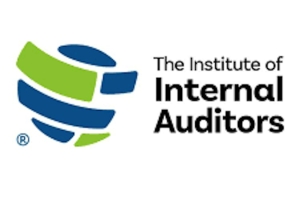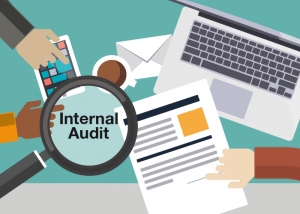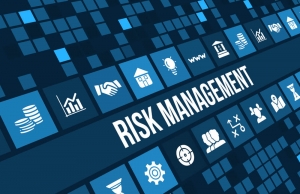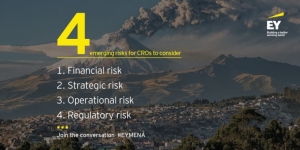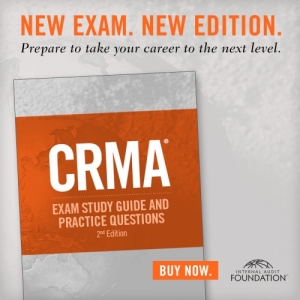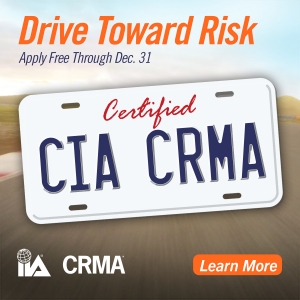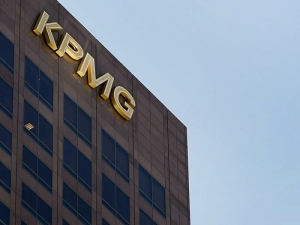عرض العناصر حسب علامة : ادارة المخاطر
الاستثمار في الذكاء الاصطناعي
يُعد الذكاء الاصطناعي (AI) أولوية إستراتيجية للشركات، لكن القيود في هذا المجال تعني أن بعض قدرات الأدوات تظل غير معروفة للمستخدمين، وقد يتعين على القوى العاملة البدء في تطوير المهارات عاجلاً وليس آجلاً.
أهم الأسباب لكي تبدأ في مهنة في إدارة المخاطر
تعد المخاطر جانبًا متأصلًا في جميع المؤسسات، وتوفر الخبرة في إدارة المخاطر فرصًا لتطوير وتنفيذ استراتيجيات للتخفيف من المخاطر لتلبية الاستراتيجيات التنظيمية ومؤشرات الأداء الرئيسية وزيادة النجاح.
يقدم معهد المدققين الداخليين الدولي للأعضاء خصمًا بنسبة 20٪ على رسوم التسجيل والامتحان
يقدم معهد المدققين الداخليين لأعضاء المعهد خصمًا بنسبة 20٪ على رسوم التسجيل والامتحان الجديد للمدقق الداخلي المعتمد (CIA) أو شهادة ضمان إدارة المخاطر (CRMA) في مايو.
أكبر التحديات في إدارة المخاطر لعام 2023
لتحقيق الازدهار في بيئة المخاطر المعقدة والمتغيرة باستمرار، يبحث قادة الأعمال اليوم عن الطريقة الأكثر فاعلية للتخفيف من مجموعة من المخاطر المحتملة التي يمكن أن تعرقل المبادرات والعمليات الاستراتيجية.
المراجعة الداخلية
تقوم المراجعة الداخلية Internal Audits بتقييم الضوابط الداخلية للشركة، بما في ذلك حوكمة الشركة وعمليات المحاسبة.
مقدمة في إدارة المخاطر
معلومات إضافية
-
المحتوى بالإنجليزية
What is Risk Management?
Risk management encompasses the identification, analysis, and response to risk factors that form part of the life of a business. Effective risk management means attempting to control, as much as possible, future outcomes by acting proactively rather than reactively. Therefore, effective risk management offers the potential to reduce both the possibility of a risk occurring and its potential impact.
Risk Management Structures
Risk management structures are tailored to do more than just point out existing risks. A good risk management structure should also calculate the uncertainties and predict their influence on a business. Consequently, the result is a choice between accepting risks or rejecting them. Acceptance or rejection of risks is dependent on the tolerance levels that a business has already defined for itself.
If a business sets up risk management as a disciplined and continuous process for the purpose of identifying and resolving risks, then the risk management structures can be used to support other risk mitigation systems. They include planning, organization, cost control, and budgeting. In such a case, the business will not usually experience many surprises, because the focus is on proactive risk management.
Response to Risks
Response to risks usually takes one of the following forms:
Avoidance: A business strives to eliminate a particular risk by getting rid of its cause.
Mitigation: Decreasing the projected financial value associated with a risk by lowering the possibility of the occurrence of the risk.
Acceptance: In some cases, a business may be forced to accept a risk. This option is possible if a business entity develops contingencies to mitigate the impact of the risk, should it occur.
When creating contingencies, a business needs to engage in a problem-solving approach. The result is a well-detailed plan that can be executed as soon as the need arises. Such a plan will enable a business organization to handle barriers or blockage to its success because it can deal with risks as soon as they arise.
Importance of Risk Management
Risk management is an important process because it empowers a business with the necessary tools so that it can adequately identify and deal with potential risks. Once a risk has been identified, it is then easy to mitigate it. In addition, risk management provides a business with a basis upon which it can undertake sound decision-making.
For a business, assessment and management of risks is the best way to prepare for eventualities that may come in the way of progress and growth. When a business evaluates its plan for handling potential threats and then develops structures to address them, it improves its odds of becoming a successful entity.
In addition, progressive risk management ensures risks of a high priority are dealt with as aggressively as possible. Moreover, the management will have the necessary information that they can use to make informed decisions and ensure that the business remains profitable.
Risk Analysis Process
Risk analysis is a qualitative problem-solving approach that uses various tools of assessment to work out and rank risks for the purpose of assessing and resolving them. Here is the risk analysis process:
1. Identify existing risks
Risk identification mainly involves brainstorming. A business gathers its employees together so that they can review all the various sources of risk. The next step is to arrange all the identified risks in order of priority. Because it is not possible to mitigate all existing risks, prioritization ensures that those risks that can affect a business significantly are dealt with more urgently.
2. Assess the risks
In many cases, problem resolution involves identifying the problem and then finding an appropriate solution. However, prior to figuring out how best to handle risks, a business should locate the cause of the risks by asking the question, “What caused such a risk and how could it influence the business?”
3. Develop an appropriate response
Once a business entity is set on assessing likely remedies to mitigate identified risks and prevent their recurrence, it needs to ask the following questions: What measures can be taken to prevent the identified risk from recurring? In addition, what is the best thing to do if it does recur?
4. Develop preventive mechanisms for identified risks
Here, the ideas that were found to be useful in mitigating risks are developed into a number of tasks and then into contingency plans that can be deployed in the future. If risks occur, the plans can be put to action.
Summary
Our business ventures encounter many risks that can affect their survival and growth. As a result, it is important to understand the basic principles of risk management and how they can be used to help mitigate the effects of risks on business entities.
كيف تستعد للمخاطر التي لا يمكنك التنبؤ بها؟
معلومات إضافية
-
المحتوى بالإنجليزية
The age of transformation and disruption was already bringing on new risks for businesses and demanding a different way of thinking. Add a global pandemic to the mix and risk management becomes a critical component to how organizations will manage the future of their business.
Organizations in both the public and private sector in the MENA region are currently facing challenges that are opening them up to risks they may not have accounted for. These include changes to the way of working, such as the need to manage the balance of people on the ground and the increased use of tech to allow remote access.
While government entities and private organizations have mostly mitigated the immediate challenges of the pandemic, there are four emerging risks that Chief Risk Officers (CROs) need to take into consideration when advising stakeholders:
1) Financial risk: The ability to continue to secure financial sustainability for any organization, whether through driving efficiency or managing cashflow
2) Strategic risk: The ability to develop a dynamic strategy that would cater to the changing environment and new way of doing business
3) Operational risk: The ability to drive an efficient and profitable operating model with a good balance between people, the use of technology, and processes
4) Regulatory risk: Whether an organization’s current regulatory framework caters to new circumstances
In order to regain stakeholder and consumer trust, CROs should facilitate discussions with other leaders about the future of the business and securing a resilient operating model.
When reviewing the organization’s risk profile and how to best mitigate new risks, CROs need to prioritize:
· The need to challenge the current strategy and rethink risk protocol in light of the change to how people are interacting with organizations and conducting their lives
· How to cater to the quickly changing needs of their audience and the new norm of doing business
· Being conscious of dynamic changes and what a new future will bring – whether that involves new technology, financial, or operating models – and addressing those challenges as well
· Addressing the talent pool and the skills and tools they will need to work in this new business environment
· Creating a new way of reporting that includes real-time insights to keep stakeholders and board members updated on the full scope and scale of risks as well as how they are impacting different business units
In the past year, many organizations in the MENA region re-examined their protocols for both internal management and audience engagement as they navigated the implications of the pandemic. It has spurred a movement among C-suite and board members to encourage innovation and the use of technology at scale to support the changing needs of employees and consumers. The willingness of an organization to invest in automation in parallel to their risk and compliance function will help build improved resilience into the evolving risk environment. And that investment in risk is how to create trust among stakeholders.
The views reflected in this article are the views of the author and do not necessarily reflect the views of the global EY organization or its member firms.
دليل دراسة اختبار شهادة ضمان إدارة المخاطر المعتمدة CRMA وأسئلة الممارسة، الإصدار الثاني
معلومات إضافية
- المحتوى بالإنجليزية With current information and trends, explanatory examples, and useful tables and figures, the CRMA® Exam Study Guide and Practice Questions, 2nd Edition, will not only serve as an aid to taking the exam but will also enhance your knowledge of risk management assurance for audit-related activity.
تقدم بطلب للحصول على شهادة ضمان إدارة المخاطر المعتمدة مجانًا في عام 2021
يتنازل معهد المدققين الداخليين (IIA) عن رسوم التقديم (تصل إلى 210 دولارًا أمريكيًا) لاعتماد شهادة ضمان إدارة المخاطر المعتمدة CRMA حتى 31 ديسمبر 2021!
معلومات إضافية
-
المحتوى بالإنجليزية
Follow the Road to CRMA Savings & Risk Readiness
The IIA is waiving the application fee (up to a $210 value) for the CRMA credential* through 31 December 2021!
Certification in Risk Management Assurance® (CRMA®)
If you’re already a CIA and your goal is to become a trusted advisor to the audit committee and executive management in the critical areas of risk assurance, governance processes, or quality assurance, the CRMA credential is for you.
Earning a certification is the best way to articulate your expertise in this essential area without saying a word. You can apply and register now then sit for the exam starting in October.
Get Started.
Risk Resources
Risk-focused Training and Development
Books & Research
These new releases provide the latest risk assessment and management tools:
NEW! CRMA Exam Study Guide and Practice Questions, 2nd Edition
Managing Risk in Uncertain Times: Leveraging COSO’S New ERM Framework
OnRisk 2021: A Guide to Understanding, Aligning, and Optimizing Risk- FREE DOWNLOAD
The Internal Auditor's Guide to Risk Assessment, 2nd Edition
The Speed of Risk: Lessons Learned on the Audit Trail, 2nd Edition
Online Training
Sharpen skills and prove competencies through online courses.
Assessing Fraud Risks
COSO Enterprise Risk Management Certificate Program (Self-study & Seminar/eSeminar)
COSO Internal Control Certificate Program (Self-study and Seminar/eSeminar)
Developing a Risk-based Audit Plan



